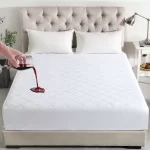House dust mites can trigger respiratory or dermatological conditions including asthma and eczema. The main component of dust is shed skin flakes, which is the mite’s preferred food source. Areas around the home that are heavily used, such as beds, carpet and upholstered furniture, will have much higher mite populations than the rest of the house.
One of the most common mites found around the house in Australia is the Dermatophagoides pteronyssinus, which tends to prefer coastal rather than inland areas. This mite has been associated with respiratory allergies in humans, such as eczema and asthma. However, there is no single, definitive sign that house dust mites trigger a person’s allergy symptoms. Asthma, for example, can be triggered by a range of other indoor allergens such as moulds or animal fluff from hair, fur or feathers. Some characteristics of a house dust mite include, less than half a millimetre in length, which makes it hard to see with the naked eye, they are wingless and have an oval shaped body they have a life span of two to three months.
Unlike other household bugs, eg. bed bugs, fleas, mosquitoes, dust mites do not bite. It’s not the dust mite that causes the health problems but the secretions and faeces they shed that can trigger allergic symptoms in susceptible people.
It doesn’t matter how clean your house is it is impossible to destroy your entire dust mite population, but you can dramatically reduce their numbers by following a few procedures. It is important to remember that the droppings of dead dust mites continue to provoke allergic reactions. You must not only reduce your dust mite population, but also take steps to remove their dead bodies and faeces from your home.
Vacuum weekly, the use of a hepper filter vacuum is important to reduce the dust omitted from the vacuum cleaner. Encase your mattress, pillows and doonas with good quality encasements. This is very important for asthma and allergy sufferers as your beds are like a big bellows, every time you move on your bed a puff of dust is thrown up entering your nose and eyes causing irritations. Encasements are waterproof thus not allowing moisture, allergens and dust mites to contaminate your bedding.
Where practical, remove carpets and rugs, bare boards and tiled floors are preferable as they can be damp mopped or cleaned with electrostatic cloths. The use of steam vac machines is extremely good as it takes away the use of toxic chemicals which can cause allergic reactions.
The washing of sheets, pillow case etc. weekly at above 55C, if washing in cold water, use a product that contains essential oils, like eucalyptus or tea tree oil.
Wash blankets and doonas every couple of months.
Do not use sheep woollen underlays and any other sheepskin products. Having a dry and well-ventilated house and have adequate floor and wall insulation and avoid evaporative coolers will all help.
For further information and help please consult your Doctor.
Image: by Gilles San Martin
Cover and Protect The Bed Protection Specialists. Sydney, Australia.
For sales or further information please visit our website or call Cover and Protect on 02 931 66654




